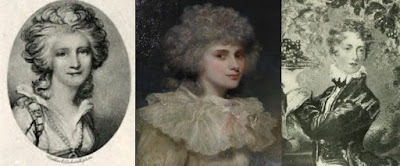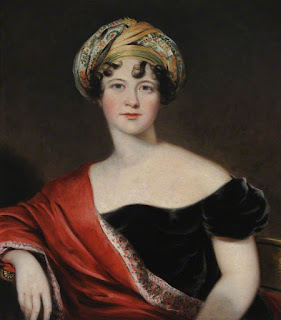 |
| From left: Lady Anne Barnard, Lady Elizabeth Foster and Lady Caro Lamb (for details of each picture, see below) |
My previous post provoked a lot of discussion. The most searching question I was asked (by my husband Andrew who is used to me muttering about titles being used wrongly) was whether titles were used correctly at the time or whether these rules were just the ‘correct’ way and abused as much as the rules of grammar are today. In response to this, I have included some examples from contemporary newspapers and magazines to illustrate whether the rules seem to have been applied or not.
I have studied the rules and drawn up some charts which show what title the married daughter of a peer takes, based on my interpretation of these rules.
Married daughters of dukes
If the daughter of a duke marries a peer, she takes his title. If she marries the eldest son of a peer, she takes his title, but in the case of the heir of an earl or lesser peer, she may choose to keep her own title until her husband inherits. In all other cases, she keeps her own title, even if she marries the younger son of a duke, as the daughter of a peer ranks higher than a younger son of the same level of peerage.
Let us take the fictitious example of Lady Augusta Hampton, daughter of the Duke of Wessex, and her marriage to Charles North of Swanage of varying rank.
Did they follow the rules?
There were very few dukes (only 18 English dukes at the end of the Regency period) and as most of their daughters married peers, I have struggled to find records of these rules coming into play.
The only example I have found is in a newspaper report on the presentations at the Queen’s Drawing Room in The Times on 13 April 1810 and this appears to show them being used wrongly. Among those presented to the Queen were Lord and Lady Leveson Gower.
Granville Leveson Gower was the younger son of the Marquess of Stafford. At this date, he had no peerage of his own. His wife was Harriet, the daughter of the Duke of Devonshire. According to the rules, I would have expected to see them listed as Lord Granville Leveson Gower (title from his father) and Lady Harriet Leveson Gower (title from her father), but in this report, both Christian names were omitted. It is hard to tell whether this is significant or just a space saving exercise in the newspaper!
 |
| Harriet, Countess Granville, by Thomas Barber the elder (1809-10), at Hardwick Hall, National Trust via Wikimedia Commons |
Married daughters of marquesses
If the daughter of a marquess marries a peer, she takes his title. If she marries the eldest son of a peer, she takes his title, but in the case of the heir of an earl or lesser peer, she may choose to keep her own title until her husband inherits. If she marries the younger son of a duke, she may choose to take his title or keep her own. In all other cases, she keeps her own title.
In this example, Lady Augusta Hampton is now the daughter of the Marquess of Denmead who is marrying Charles North of Swanage of varying rank.
As with dukes, there were similarly few marquesses in the Regency and I have no records of examples to share.
Married daughters of earls
If the daughter of an earl marries a man of equal or greater rank, she takes his title. In all other cases she retains her own title.
Lady Augusta Hampton is now the daughter of the Earl of Harting who is marrying Charles North of Swanage of varying rank.
There were many more earls than dukes or marquesses in the Regency and there are plenty of instances of daughters of peers marrying commoners and retaining their titles. For example, Lady Anne Lindsay, the daughter of the 5th Earl of Balcarres, married a commoner, Andrew Barnard, and became known as Lady Anne Barnard (You can read about her here.)
 |
| Lady Anne Barnard from South Africa a Century Ago (1910) |
 |
| Lady Elizabeth Foster, later Duchess of Devonshire, in South Sketch Gallery, Chatsworth |
Earl’s daughter marrying heir of viscount
Caroline Ponsonby was the daughter of Frederick Ponsonby, Viscount Duncannon. When her father became 3rd Earl of Bessborough, Caroline became known as Lady Caroline Ponsonby, and she kept this title on her marriage to William Lamb, who had no courtesy title as the eldest surviving son of Viscount Melbourne. As Caroline died before William inherited, she never shared his title.
 |
| Lady Caroline Lamb from Wives of the Prime Ministers (1844-1906) |
Lady Anne Lowther, daughter of William Lowther, Earl of Lonsdale, married Sir John Beckett, Baronet. In an illustrative memoir in La Belle Assemblée in 1829, she was referred to as Lady Anne Beckett.
Married daughters of viscounts
If the daughter of a viscount marries a man of equal or higher rank, she takes his title. If she marries a man of lower rank, she retains her own title.
The Honourable Augusta Hampton is now the daughter of the Viscount Droxford who is marrying Charles North of Swanage of varying rank.
Married daughters of barons
If the daughter of a baron marries a man of equal or higher rank, she takes his title. If she marries a man of lower rank, she retains her own title.
A note about the use of “The Honourable”
The daughter of a peer ranks lower than the eldest son of the same level of peer and higher than the younger sons of the same level of peer. However, where both titles are “The Honourable” but the wife’s rank is higher (those entries marked *), I have not been able to determine whether she would use her Christian name or her husband’s or neither. It should be noted that the title “The Honourable” is never used in speech and according to Black’s, their visiting cards would simply state Mr North and Mrs North, without title or Christian names.
Rachel Knowles writes clean/Christian historical romance set in the time of Jane Austen. She has been sharing her research on this blog since 2011. Rachel lives in the beautiful Georgian seaside town of Weymouth, Dorset, on the south coast of England, with her husband, Andrew.
Find out more about Rachel's books and sign up for her newsletter here.If you have enjoyed this blog and want to encourage me and help me to keep making my research freely available, please buy me a virtual cup of coffee by clicking the button below.
Sources used include:
A Member of the Aristocracy, Manners and Rules of Good Society (1888) (1916)
A Member of the Aristocracy, Manners and Tones of Good Society pre 1880
Bell, John, La Belle Assemblée (John Bell, 1806-1837, London)
Black, Adam and Charles (publishers), Titles and forms of address - a guide to their correct use (9th edition)(1955)
Black, Adam and Charles (publishers), Titles and forms of address - a guide to their correct use (9th edition)(1955)
Debrett, John, The Peerage of the United Kingdom of Great Britain and Ireland (1820)
Lamb, Charles (?), A book explaining the ranks and dignities of British Society (1809)







One sees this done wrongly so often in fiction. I was pleased to see you had this correct.
ReplyDelete